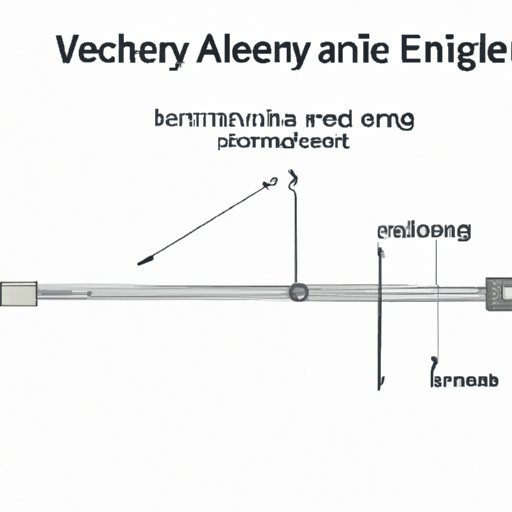
I. Introduction
Angular velocity is a fundamental concept in physics and engineering that describes the rate at which an object rotates around a central axis. It provides important information about an object’s motion and is used in a wide range of applications, from robotics and mechanics to space exploration and sports science. Knowing how to calculate angular velocity is essential for anyone studying physics, engineering, or any other field where motion is a key factor.
II. A Beginner’s Guide to Finding Angular Velocity: Understanding the Basics
Angular velocity is defined as the change in angle per unit time, typically measured in radians per second. The formula for calculating angular velocity is:
ω = Δθ/Δt
Where ω is angular velocity, Δθ is the change in angle (measured in radians), and Δt is the change in time. In other words, angular velocity describes how fast an object is rotating and in what direction.
For example, imagine a wheel spinning on an axle. The wheel’s angular velocity would be the rate at which it completes a full rotation around the axle, measured in radians per second.
III. Solving for Angular Velocity: Step by Step Guide for Physics Enthusiasts
To solve for angular velocity, it is important to understand some key physics concepts related to rotation and motion. These include:
- The relationship between linear and angular velocity
- The difference between clockwise and counterclockwise rotation
- The use of radians instead of degrees to measure angles
With these concepts in mind, calculating angular velocity involves a simple formula, but it can be challenging to apply in practice. Here is a step-by-step guide to help you through the process:
- Determine the change in angle (Δθ) – This is the difference between the object’s starting position and its ending position. The angle should be measured in radians.
- Determine the change in time (Δt) – This is the difference between the starting time and the ending time. The time should be measured in seconds.
- Divide the change in angle by the change in time – This will give you the angular velocity in radians per second.
It’s important to note that when dealing with rotation in three-dimensional space, there may be more than one axis of rotation to consider. In these cases, the above formula may need to be adapted to account for each axis separately.
IV. Mastering Angular Velocity Calculations: Tips and Tricks for Engineering Students
For those studying engineering or other advanced fields, a deeper understanding of angular velocity may be required. In these cases, there are several techniques that can help simplify and streamline the calculation process:
- Using calculus to solve for instantaneous angular velocity – This involves taking the limit of the change in angle and time as they approach zero, and can provide a more precise measurement of angular velocity.
- Using vector calculus to handle complex variable relationships – This technique involves breaking down angular velocity into its component vectors in order to better understand its direction and magnitude.
- Applying advanced mathematical concepts such as Fourier analysis or Laplace transforms – These techniques are beyond the scope of this article but can be useful in certain applications.
When dealing with non-standard or irregular motion, such as the rotation of a planet or the movement of an articulated robot arm, specialized techniques may be required to accurately calculate angular velocity. However, these techniques are typically only used in highly specific contexts and are not required for most everyday calculations.
V. Exploring the Importance of Angular Velocity in Robotics and Mechanics
Angular velocity plays a critical role in many fields related to motion and mechanics, particularly robotics. In robotics, angular velocity is used to describe the speed and direction of rotational motion in robotic arms, wheels, and other moving parts. Knowing the angular velocity of these components is essential for controlling their movements and ensuring they operate safely and accurately.
In other applications, such as satellite motion or vehicle dynamics, angular velocity can provide important information about the object’s orientation and rotational stability. In sports science, angular velocity is used to analyze the movements of athletes, such as the rotation of a figure skater or the spin of a baseball pitch.
VI. Proven Techniques for Calculating Angular Velocity Easily and Accurately
When it comes to calculating angular velocity, there are several tips and tricks that can help simplify the process and avoid common errors:
- Be sure to use radians instead of degrees when measuring angles
- Double-check your calculations to avoid errors in units or arithmetic
- Use the appropriate formula depending on the axis of rotation or type of motion being measured
- Remember that angular velocity can be positive or negative, depending on the direction of rotation
- Practice with a variety of examples and problems to develop a stronger understanding of the concepts involved
By following these best practices and being diligent in your calculations, you can improve your accuracy and confidence when dealing with angular velocity.
VII. Conclusion
Angular velocity is a key concept in physics and engineering that provides important information about an object’s rotational motion. Whether you are just starting to learn about the topic or are an experienced professional, understanding how to calculate and apply angular velocity is essential for success in many fields. By following the tips and techniques outlined in this article, you can improve your mastery of angular velocity and achieve greater precision and accuracy in your calculations.
To continue learning and practicing, consider exploring further resources such as textbooks, online courses, or practice problems. With dedication and persistence, anyone can become adept at calculating and working with angular velocity.




